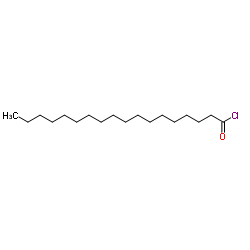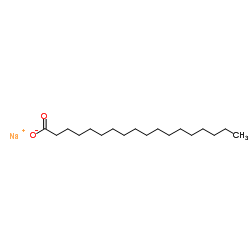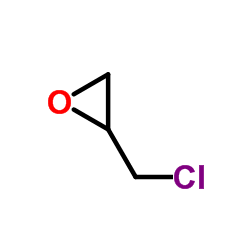7460-84-6
| 中文名 | 硬脂酸缩水甘油基酯 |
|---|---|
| 英文名 | Glycidyl Stearate |
| 中文别名 | 缩水甘油酯硬脂酸 |
| 英文别名 |
Octadecanoic acid, oxiranylmethyl ester
Octadecanoic acid, oxiranylmethyl ester (9CI) 2-Oxiranylmethyl stearate oxiran-2-ylmethyl octadecanoate Oxiran-2-ylmethyl stearate Stearic acid glycidyl ester |
| 密度 | 0.9±0.1 g/cm3 |
|---|---|
| 沸点 | 424.7±18.0 °C at 760 mmHg |
| 熔点 | 53ºC |
| 分子式 | C21H40O3 |
| 分子量 | 340.540 |
| 闪点 | 161.8±6.1 °C |
| 精确质量 | 340.297760 |
| PSA | 38.83000 |
| LogP | 8.73 |
| 外观性状 | 固体;White to Almost white powder to crystal |
| 蒸汽压 | 0.0±1.0 mmHg at 25°C |
| 折射率 | 1.462 |
| 储存条件 | 密封于阴凉干燥环境 |
| 稳定性 | 如果遵照规格使用和储存则不会分解。 |
| 分子结构 | 1、 摩尔折射率:100.68 2、 摩尔体积(m3/mol):365.9 3、 等张比容(90.2K):889.8 4、 表面张力(dyne/cm):34.9 5、 极化率(10-24cm3):39.91 |
| 计算化学 | 1.疏水参数计算参考值(XlogP):8.2 2.氢键供体数量:0 3.氢键受体数量:3 4.可旋转化学键数量:19 5.互变异构体数量:无 6.拓扑分子极性表面积38.8 7.重原子数量:24 8.表面电荷:0 9.复杂度:291 10.同位素原子数量:0 11.确定原子立构中心数量:0 12.不确定原子立构中心数量:1 13.确定化学键立构中心数量:0 14.不确定化学键立构中心数量:0 15.共价键单元数量:1 |
| 更多 | 1. 性状:无可用 2. 密度(g/mL,25/4℃): 无可用 3. 相对蒸汽密度(g/mL,空气=1):无可用 4. 熔点(ºC):53 5. 沸点(ºC,常压):193/ 1mmHg 6. 沸点(ºC,5.2kPa): 无可用 7. 折射率: 无可用 8. 闪点(ºC): 无可用 9. 比旋光度(º):无可用 10. 自燃点或引燃温度(ºC):无可用 11. 蒸气压(kPa,25ºC):无可用 12. 饱和蒸气压(kPa,60ºC):无可用 13. 燃烧热(KJ/mol):无可用 14. 临界温度(ºC):无可用 15. 临界压力(KPa):无可用 16. 油水(辛醇/水)分配系数的对数值:无可用 17. 爆炸上限(%,V/V):无可用 18. 爆炸下限(%,V/V): 无可用 19. 溶解性: 无可用 |
|
Section I.Chemical Product and Company Identification Chemical Name Stearic Acid Glycidyl Ester Portland OR Synonym2,3-Epoxy-1-propanol Stearate Chemical FormulaC17H35COOCH2C2H3O CAS Number7460-84-6 Section II.Composition and Information on Ingredients Chemical NameCAS Number Percent (%)TLV/PELToxicology Data Stearic Acid Glycidyl Ester7460-84-6-------------This chemical is classified asNot available. a possible carcinogen. There is no acceptable exposure limit for a carcinogen. Section III. Hazards Identification Acute Health EffectsNo specific information is available in our data base regarding the toxic effects of this material for humans. However, exposure to any chemical should be kept to a minimum. Skin and eye contact may result in irritation. May be harmful if inhaled or ingested. Always follow safe industrial hygiene practices and wear proper protective equipment when handling this compound. Chronic Health EffectsCARCINOGENIC EFFECTS : Possible carcinogen. (sufficient evidence in animals, no adaquate data in humans) Tumorigenic: Rat (subcutaneous) 2500 mg/kg/5W-I. Equivocal tumorigenic by RTECS criteria. Tumorigenic: Mouse (subcutaneous) 52 mg/kg/26W-I. Equivocal tumorigenic by RTECS criteria. MUTAGENIC EFFECTS : Not available. TERATOGENIC EFFECTS : Not available. DEVELOPMENTAL TOXICITY: Not available. Repeated or prolonged exposure to this compound is not known to aggravate existing medical conditions. Section IV.First Aid Measures Eye ContactCheck for and remove any contact lenses. DO NOT use an eye ointment. Flush eyes with running water for a minimum of 15 minutes, occasionally lifting the upper and lower eyelids. Seek medical attention. Treat symptomatically and supportively. Skin ContactAfter contact with skin, wash immediately with plenty of water. Gently and thoroughly wash the contaminated skin with running water and non-abrasive soap. Be particularly careful to clean folds, crevices, creases and groin. Cover the irritated skin with an emollient. Seek medical attention. Treat symptomatically and supportively. Wash any contaminated clothing before reusing. InhalationIf the victim is not breathing, perform artificial respiration. Loosen tight clothing such as a collar, tie, belt or waistband. If breathing is difficult, oxygen can be administered. Seek medical attention. Treat symptomatically and supportively. IngestionINDUCE VOMITING by sticking finger in throat. Lower the head so that the vomit will not reenter the mouth and throat. Loosen tight clothing such as a collar, tie, belt, or waistband. If the victim is not breathing, administer artificial respiration. Examine the lips and mouth to ascertain whether the tissues are damaged, a possible indication that the toxic material was ingested; the absence of such signs, however, is not conclusive. Seek immediate medical attention and, if possible, show the chemical label. Treat symptomatically and supportively. Section V. Fire and Explosion Data Not available. FlammabilityCombustible.Auto-Ignition Flash PointsFlammable Limits Not available.Not available. Combustion Products These products are toxic carbon oxides (CO, CO 2). Fire Hazards No specific information is available regarding the flammability of this compound in the presence of various materials. Explosion HazardsRisks of explosion of the product in presence of mechanical impact: Not available. Risks of explosion of the product in presence of static discharge: Not available. No additional information is available regarding the risks of explosion. Continued on Next Page Stearic Acid Glycidyl Ester Fire Fighting Media SMALL FIRE: Use DRY chemicals, CO 2, water spray or foam. and InstructionsLARGE FIRE: Use water spray, fog or foam. DO NOT use water jet. Section VI.Accidental Release Measures Spill CleanupHarmful material. InstructionsIn case of a spill and/or a leak, always shut off any sources of ignition, ventilate the area, and exercise caution. Use a shovel to put the material into a convenient waste disposal container. Finish cleaning the spill by rinsing any contaminated surfaces with copious amounts of water. Consult federal, state, and/or local authorities for assistance on disposal. Section VII. Handling and Storage POSSIBLE CARCINOGEN. Keep away from heat and sources of ignition. Mechanical exhaust required. When not in Handling and Storage use, tightly seal the container and store in a dry, cool place. Avoid excessive heat and light. DO NOT breathe dust. In Information case of insufficient ventilation, wear suitable respiratory equipment. If you feel unwell, seek medical attention and show the label when possible. Treat symptomatically and supportively. Avoid contact with skin and eyes. Always store away from incompatible compounds such as oxidizing agents. Section VIII. Exposure Controls/Personal Protection Engineering ControlsUse process enclosures, local exhaust ventilation, or other engineering controls to keep airborne levels below recommended exposure limits. If user operations generate dust, fume or mist, use ventilation to keep exposure to airborne contaminants below the exposure limit. Personal ProtectionSplash goggles. Lab coat. Dust respirator. Boots. Gloves. A MSHA/NIOSH approved respirator must be used to avoid inhalation of the product. Suggested protective clothing might not be sufficient; consult a specialist BEFORE handling this product. Exposure LimitsThis chemical is classified as a possible carcinogen. There is no acceptable exposure limit for a carcinogen. Section IX. Physical and Chemical Properties Physical state @ 20°CWhite crystalline powder.Solubility Not available. Not available. Specific Gravity Molecular Weight340.55Partition Coefficient Not available. Boiling PointVapor Pressure Not available.Not available. 51 to 53°C (123.8 to 127.4°F)Not available. Melting PointVapor Density Refractive IndexNot available.VolatilityNot available. Critical TemperatureNot available.OdorNot available. ViscosityNot available.TasteNot available. Section X.Stability and Reactivity Data Stability This material is stable if stored under proper conditions. (See Section VII for instructions) Conditions of Instability Avoid excessive heat and light. Incompatibilities Reactive with oxidizing agents. Section XI. Toxicological Information RTECS NumberWI3500000 Routes of ExposureEye contact. Inhalation. Ingestion. Toxicity DataNot available. CARCINOGENIC EFFECTS : Possible carcinogen. Chronic Toxic Effects (sufficient evidence in animals, no adaquate data in humans) Tumorigenic: Rat (subcutaneous) 2500 mg/kg/5W-I. Equivocal tumorigenic by RTECS criteria. Tumorigenic: Mouse (subcutaneous) 52 mg/kg/26W-I. Equivocal tumorigenic by RTECS criteria. MUTAGENIC EFFECTS : Not available. TERATOGENIC EFFECTS : Not available. DEVELOPMENTAL TOXICITY: Not available. Repeated or prolonged exposure to this compound is not known to aggravate existing medical conditions. Acute Toxic EffectsNo specific information is available in our data base regarding the toxic effects of this material for humans. However, exposure to any chemical should be kept to a minimum. Skin and eye contact may result in irritation. May be harmful if inhaled or ingested. Always follow safe industrial hygiene practices and wear proper protective equipment when handling this compound. Continued on Next Page Stearic Acid Glycidyl Ester Section XII.Ecological Information EcotoxicityNot available. Environmental FateNot available. Section XIII. Disposal Considerations Recycle to process, if possible. Consult your local or regional authorities. You may be able to dissolve or mix material with Waste Disposal a combustible solvent and burn in a chemical incinerator equipped with an afterburner and scrubber system. Observe all federal, state, and local regulations when disposing of this substance. Section XIV. Transport Information DOT ClassificationNot a DOT controlled material (United States). PIN NumberNot applicable. Proper Shipping Name Not applicable. Packing Group (PG)Not applicable. DOT Pictograms Section XV. Other Regulatory Information and Pictograms TSCA Chemical InventoryThis product is NOT on the EPA Toxic Substances Control Act (TSCA) inventory. The following notices are required by 40 CFR 720.36 (C) for those products not on the inventory list: (EPA) (i) These products are supplied solely for use in research and development by or under the supervision of a technically qualified individual as defined in 40 CFR 720.0 et sec. (ii) The health risks of these products have not been fully determined. Any information that is or becomes available will be supplied on an MSDS sheet. WHMIS ClassificationNot controlled under WHMIS (Canada). (Canada) EINECS Number (EEC) Not available. EEC Risk StatementsNot available. SECTION 16 - ADDITIONAL INFORMATION N/A |
|
毒理学数据: 试验方法:皮下 生态学数据: 通常对水是不危害的,若无政府许可,勿将材料排入周围环境。 CHEMICAL IDENTIFICATION
HEALTH HAZARD DATAACUTE TOXICITY DATA
MUTATION DATA
|
| RTECS号 | WI3500000 |
|---|---|
| 海关编码 | 2915709000 |
|
~% 
7460-84-6 |
| 文献:US2005/234121 A1, ; Page/Page column 13 ; |
|
~% 
7460-84-6 |
| 文献:Helvetica Chimica Acta, , vol. 9, p. 711 |
|
~% 
7460-84-6 |
| 文献:Journal of Organic Chemistry, , vol. 8, p. 550,554 |
| 海关编码 | 2915709000 |
|---|---|
| 中文概述 | 2915709000. 棕榈酸及其盐和酯、硬脂酸盐、酯. 增值税率:17.0%. 退税率:13.0%. 监管条件:无. 最惠国关税:5.5%. 普通关税:30.0% |
| 申报要素 | 品名, 成分含量, 用途, 硬脂酸和软脂酸的含量 |
| Summary | 2915709000. palmitic acid and its salts and esters. VAT:17.0%. Tax rebate rate:13.0%. . MFN tariff:5.5%. General tariff:30.0% |






